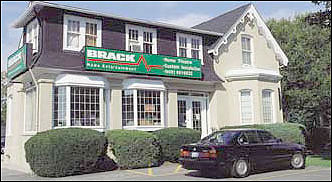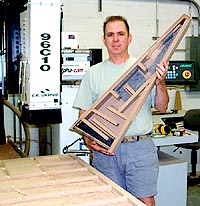 |
|||||||||||||||||
 |
|||||||||||||||||
| I came across today's interesting product while making my semi-annual rounds to various HiFi shops in Toronto. While I may not be looking for a particular product, I somehow always manage to come home with a somewhat depleted bank account. I'm sure you've never had similar experiences. Right? I really don't consider myself a tweak. Of course, as I write this, I'm surrounded by a butt-load of cones, cables and other assorted doo-dads. I see the role of products like the Notepad to fine-tune a system rather than drastically alter it like a major component change might do - just as a pinch or two of spice to shift flavor. |
|||||||||||||||||
| So, what did I come home with at the end of my tour this time? Other than a handful of CDs and SACDs, I also arrived with three GutWire Notepads. Who/what is GutWire and what is a Notepad? GutWire is a Canadian outfit that offers a wide assortment of signal cables, power cables and connectors. Up until recently, they were generally known primarily for their power cables, which I've been told are quite good. GutWire now also offers other accessories such as the MaxCon power conditioner and the aforementioned Notepad. The Notepad sells for about CDN$35/ea., or roughly US$25. The Notepad is a small black bag made from what appears to be heavy gauge nylon sized approximately 7" x 5"x 1", which contains a rather heavy, viscous goo. That's right, goo. This stuff is a non-toxic "specially formulated cellulose high-molecular polymer gel". Sure sounds like goo to me. Its mission, according to the maker, is "to absorb vibration, unwanted resonance, EMI and RFI". | |||||||||||||||||
 |
|||||||||||||||||
Cool. I'm not going to get into a long exploration of how various vibration control products supposedly work. That generally bores me to tears and well, frankly, I just don't fully comprehend the subject's intricacies to do it any justice other than theorize. However, I have experimented with many similar products to discover that they all more or less affected sonic performance in ways (some good, some not so good) that were easy to detect on even a modest setup like mine. The best ones like the Black Diamond Racing cones add focus, definition and appear to extend frequency extremes without shifting the tonal balance up or down. |
|||||||||||||||||
| GutWire recommends to place each Notepad either under sources of vibration, or directly atop CD/DVD/SACD drive mechanisms and transformers in preamps or power amps. GutWire also recommends placing them on loudspeakers to dampen cabinet resonances and under speaker cables to avoid static build up, especially when those are run across carpet. Each Notepad will support 22lbs. I tried them as suggested, on all my components and in every which way possible. All I can say is that I wish I had more. They really do work. I'd love to experiment further. Now, don't ask me how a little bag of goo could alter the sound of a speaker like the Meadowlark Kestrel2 with its extremely well-built, rock-solid enclosure. But it does. |
|||||||||||||||||
 |
|||||||||||||||||
I'm sure speaker and component manufacturers roll up their eyes upon learning how audiophiles like us screw up the sound of their gear which they laboured so hard to get just so. I reckon that no matter how well a loudspeaker or component is constructed, there'll always remain little pockets of unwanted resonances that still affect the sound. By adding a product like the Notepad, those resonances might be reduced or at least shifted in frequency such as to, hopefully, improve the component's subjective performance. Notice my disclaimer. Hopefully. Just because a vibration control product like the Notepad can alter a component's effect on music playback does not necessarily mean that everyone would perceive it as improvement. What I call an improvement, in my system, may equate to a backwards step to you, in yours. Furthermore, I believe audiophiles often mistake every little audible difference as being an improvement when it's really just a small difference. |
|||||||||||||||||
 |
|||||||||||||||||
| What did I experience with the Notepads? In general, a smoother, more relaxed character to music playback. I heard this as deeper, firmer, more defined bass; a more coherent midrange, with glare on brass, strings and vocals noticeable by its absence. The performance became more musically coherent. The effect was not unlike that of a good power conditioner, or noise-canceling power cables like my Wireworlds. This sonic goodness was noticeable on whatever music I chose to listen to (a very good thing in my book), be it the cool Jazz of The Ray Brown Trio on Soular Energy [Groove Note GRV1015-3], the Indian-influenced electroacoustic hypercussion of Tala Matrix [Tabla Beat Science, Axiom PALMCD 2046-2], or those lovely, slightly veiled strings of the Staatskapelle Dresden in Mozart's last 5 symphonies [Philips Duo 470 540-2]. All components seemed to benefit no matter where I placed the damper pads. However, my two silver disc spinners, the Rotel RCD-971 CD and Sony SCD-XE670 SACD players, gained the most from the addition of Notepads either atop or below them. I can't verify whether the Notepads indeed reduce RFI/EMI as claimed by GutWire. But since I experienced the biggest improvement on my digital gear, it would seem that some ultra-sonic attenuation of grunge and interference is indeed going on. Incidentally, placing a NotePad on the Bryston B60 also had similarly positive effect. |
|||||||||||||||||
 |
|||||||||||||||||
 |
 |
||||||||||||||||
|
Will telling you that Notepads worked great in conjunction with my BDR cones stretch your credulity? Again, don't ask me why. I just call 'em as I hear 'em. I suspect that both products affect different resonance bands to create some additive synergy. I also tried Notepads under my speaker cables but couldn't hear any difference. Mind you, I already keep my cables off the carpet with some rebar chairs (hey, it sounds better to me) so I probably already have eliminated any potential static charges from bothering my wires. I should mention that I have heard the Notepads on a higher resolution system than mine, with Meadowlark Shearwater Hot Rods, Classé and PS Audio gear. I found the sonic improvements much greater and easier to discern. That shouldn't come as a surprise. The more resolving a system, the more it will magnify alterations to make differences easier to pick out. Still, I heard a worthwhile improvement on my modest setup and found the cost-to-return ratio worthwhile. Gee, I wonder if putting them on my head will stop migraines?
I can envision instances where the Notepads might be too much of a good thing, such as putting too many on or under a single component. When I placed my three under the Bryston B60, the bass turned a mite sluggish, boomy and out of control. Music in general became over-damped and slightly shut down when I overdid mass loading. One on top worked fine. You should be okay with one or two per component - unless, of course, your component exceeded the weight capacity of the Notepads for a support application. You wouldn't want them to bust and goo all over your equipment, would you now? As my family physician reminds us: Everything in moderation, friend. I would only caution against the Notepads if your system were deliberately voiced on the warm, fuzzy and laid back side. The Notepads could tidy up and damp things more than you might enjoy. Otherwise, go out and acquire 2 or 3 dozen of these. Just kidding. Naturally, how many you might want isn't for me to answer. See if you can first borrow some or start out with 3 or 4. Don't expect jaw-dropping, oh-my-gawd results. Still, you should be able to readily appreciate their effects. If they put wind in your sails, go for it. After all, they are only CDN$35/ea. I understand that some dealers are offering 3 for $90. In this age of $20,000 speaker cables, the GutWire Notepads are a sweet deal whose benefits far exceed what their very modest cost might suggest. |
|||||||||||||||||
 |
|||||||||||||||||
|
Manufacturer's website
|
|||||||||||||||||
 |
|||||||||||||||||